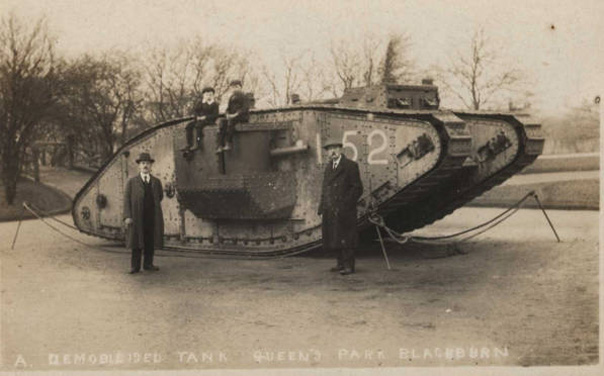Anyone who has followed my articles will know that there are certain items of Barlick lore that crop up every now and again as I pursue them through my reading and the archives. One of them is the Letcliffe Tank. For anyone who doesn’t know about this, round about the end of the First World War, the government presented Barlick with one of the first Tanks and it was brought in by rail and driven up to Letcliffe Park where it stood on a plinth for many years. I haven’t yet got to the bottom of this story but recently I found out more about it.
We need a bit of explanation here for the younger readers. Everyone nowadays knows about tanks, they have seen them in films and newsreels. Who can forget the image of the student in Tienamin Square defying a tank during the riots? Many people don’t realise that they were a British invention designed to break the dreadful stalemate on the Western Front in the First World War. Caterpillar tracks were well known before the war, the Holt Company in California were building large agricultural tractors equipped with them and the American Army was looking at using them for towing large field guns long before they entered the war.
It was decided to build armoured pill boxes and mount them on caterpillar tracks so they could move, a sort of mobile strongpoint. William Foster and Company at Lincoln who built steam traction engines were given an order and because it was secret they described them as ‘tanks’ and this is how they got their name. They built two versions, the ‘male’ one had three small six-pounder field guns, the ‘female’ had machine guns. Most historians agree that the War Office completely missed out on the fact that a new weapon made possible a new kind of warfare and they used them in dribs and drabs as a ‘mobile trench’.
On the 15th September 1916 tanks went into action for the first time on the Somme. Many officers thought a great chance had been wasted and several papers were written which advocated using tanks in great numbers to break the line and create a ‘mobile war’. It is almost certain that after the war these opinions were known in Germany and perhaps played a part in the development of the tactics of ‘Blitzkrieg’ (‘Lightning War’) which was so successful in the Second World War.
Apart from the death and destruction involved, wars cost money and one of the government’s tasks was to raise as much money as it could from the public. One of the ways this was done in both World Wars was by War Savings. Ordinary people invested money in savings which would be used to pay for the war and would be repaid after the war was over. The government realised that the tanks had captured the public’s imagination and sent tanks round the country as ‘Tank Banks’. A tank would arrive in a city, park in the main square and accept contributions towards War Savings. At the end of 1916 with the National Debt approaching £6billion this was essential war service.
At the end of the war, the Army Council had 265 battered tanks on its hands which had been brought home from France. They gave these hulks to the National War Savings Committee for presentation to towns of over 10,000 inhabitants who had made conspicuous contributions to War Savings. Barlick must have been one of these towns and it was part of this gesture that resulted in the tank on Letcliffe.
However, for a historian, there is a sting in the tail. When the tanks were finally installed in their final resting place, the mechanics who had brought them were instructed to remove ‘a portion of the mechanism by which the tanks are driven and also the wedges of the guns’. Why bother? Did they think someone might use them?
Incredible though it may seem, the answer to these questions is yes! 1919 was the year of the Russian Revolution and the ‘Red Menace’ was seen as a real threat. In January 1919, two tanks were sent to Glasgow to help celebrate Victory Week. At the same time there was a report in the Glasgow Herald that Councillor Emmanuel Shinwell, later to be a Cabinet Minister in the Second World War, had addressed a meeting of the Glasgow Trades and Labour Council and called for a general strike to take place on the 27th January to support their claim for a forty hour week. On the 29th there was a mass procession in the city and ‘Red Clydeside’ on the march was perceived as a threat.
By the 3rd of February troops had been moved in, Shinwell and his fellow ‘conspirators’ were under arrest and on the 4th, a squadron of tanks was moved into the cattle market on Gallowgate ready for use against the workers if needed. They were used again during the National Strike in 1926. Shades of Tienamin Square! As far as I can see, we were the first to see tanks as a means of controlling civil unrest. Would the lads in Barlick have used the Letcliffe Tank against the millowners? I doubt it somehow but when you look at what was happening at the time you can understand why the government thought it a wise precaution to disable Barlick’s tank!
If you want to learn more about this subject I can recommend Patrick Wright’s wonderful book called ‘TANK’ which is where I gained my latest clues about the Letcliffe Tank.
SCG/12 August 2002
964 words.

30 ton World War One tank like the one that was in Letcliffe Park.







